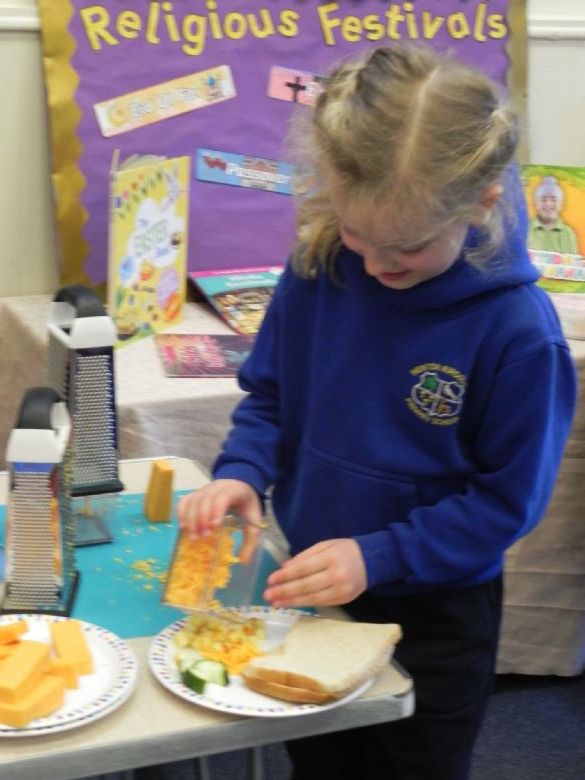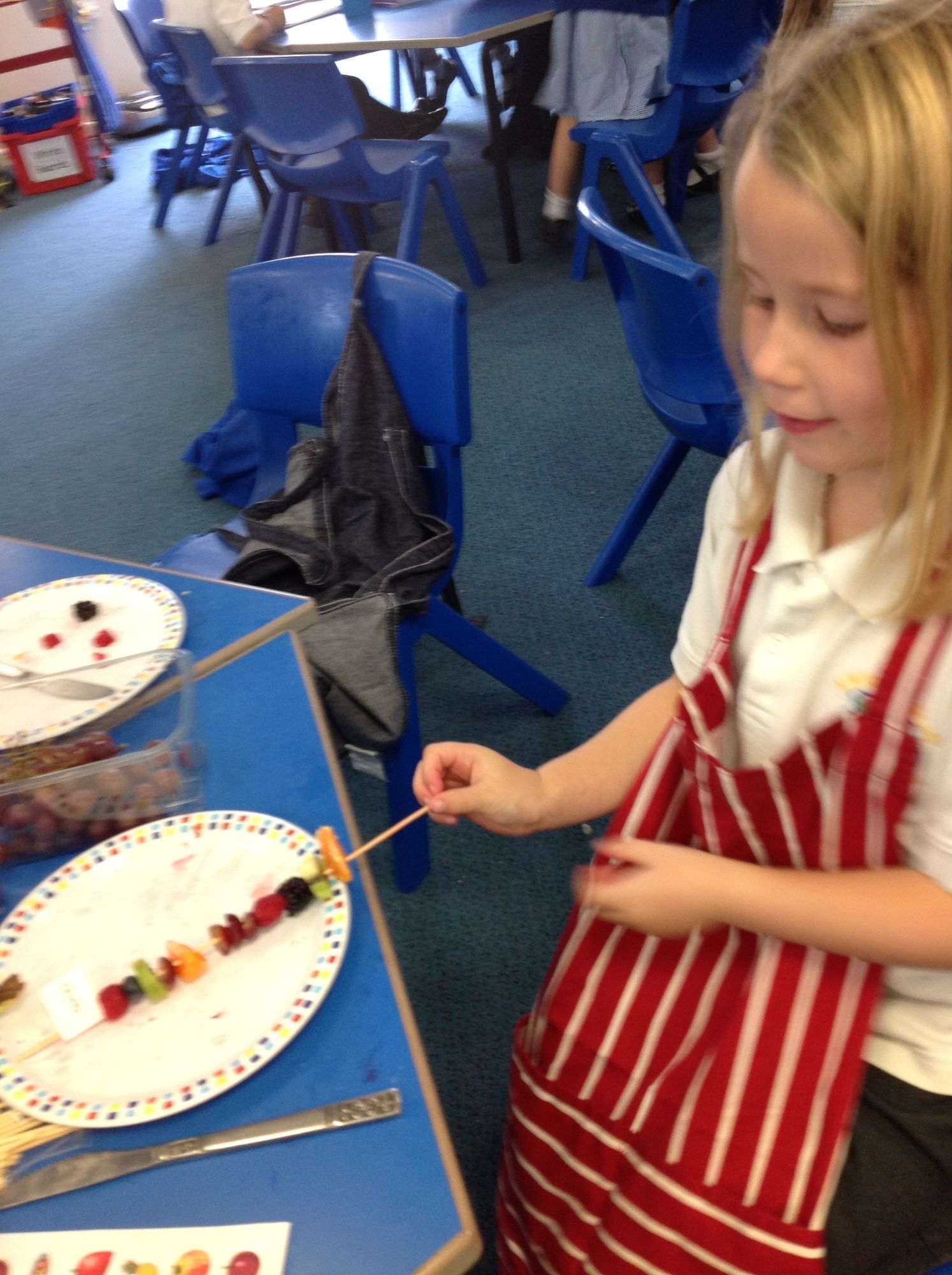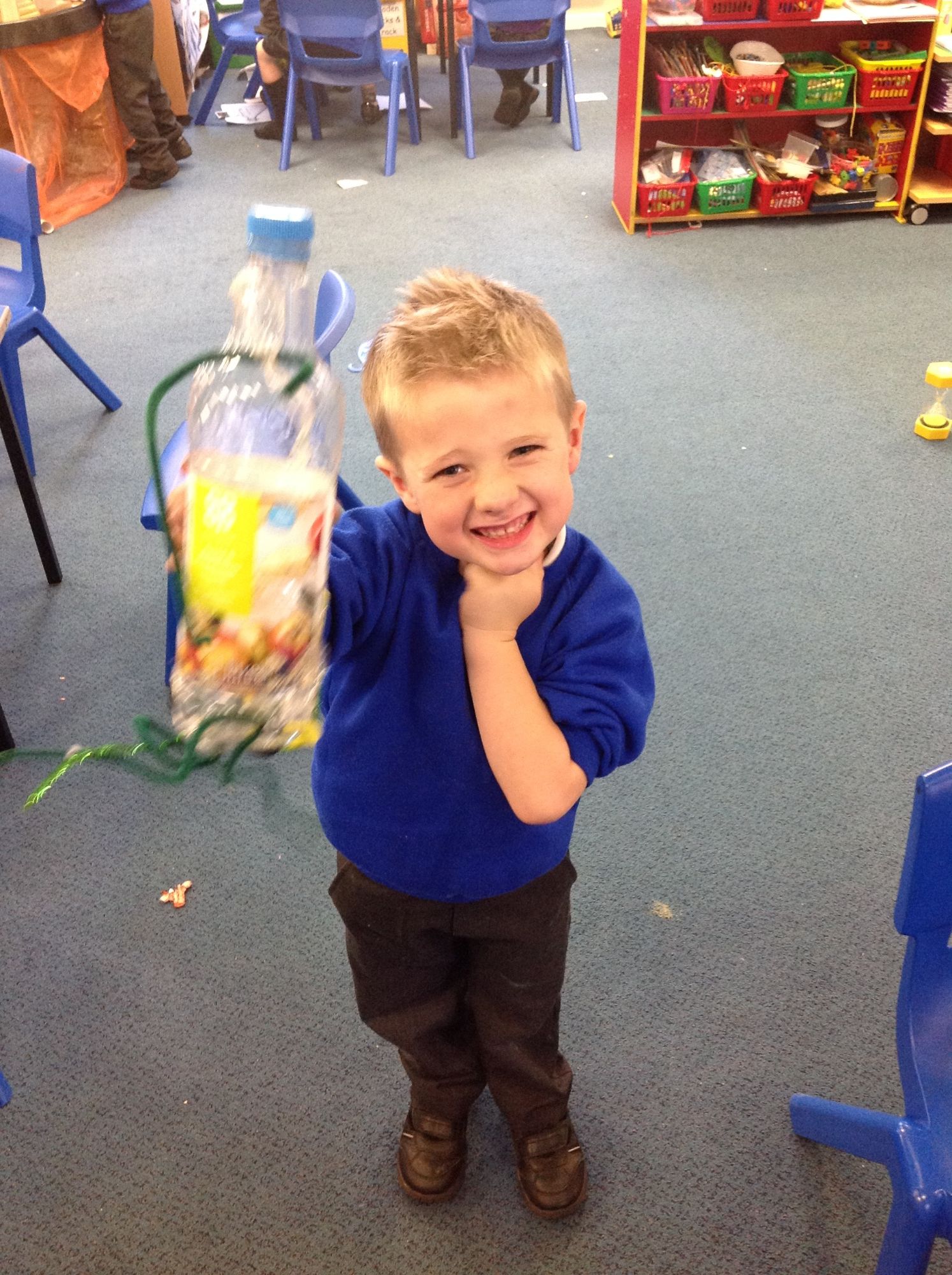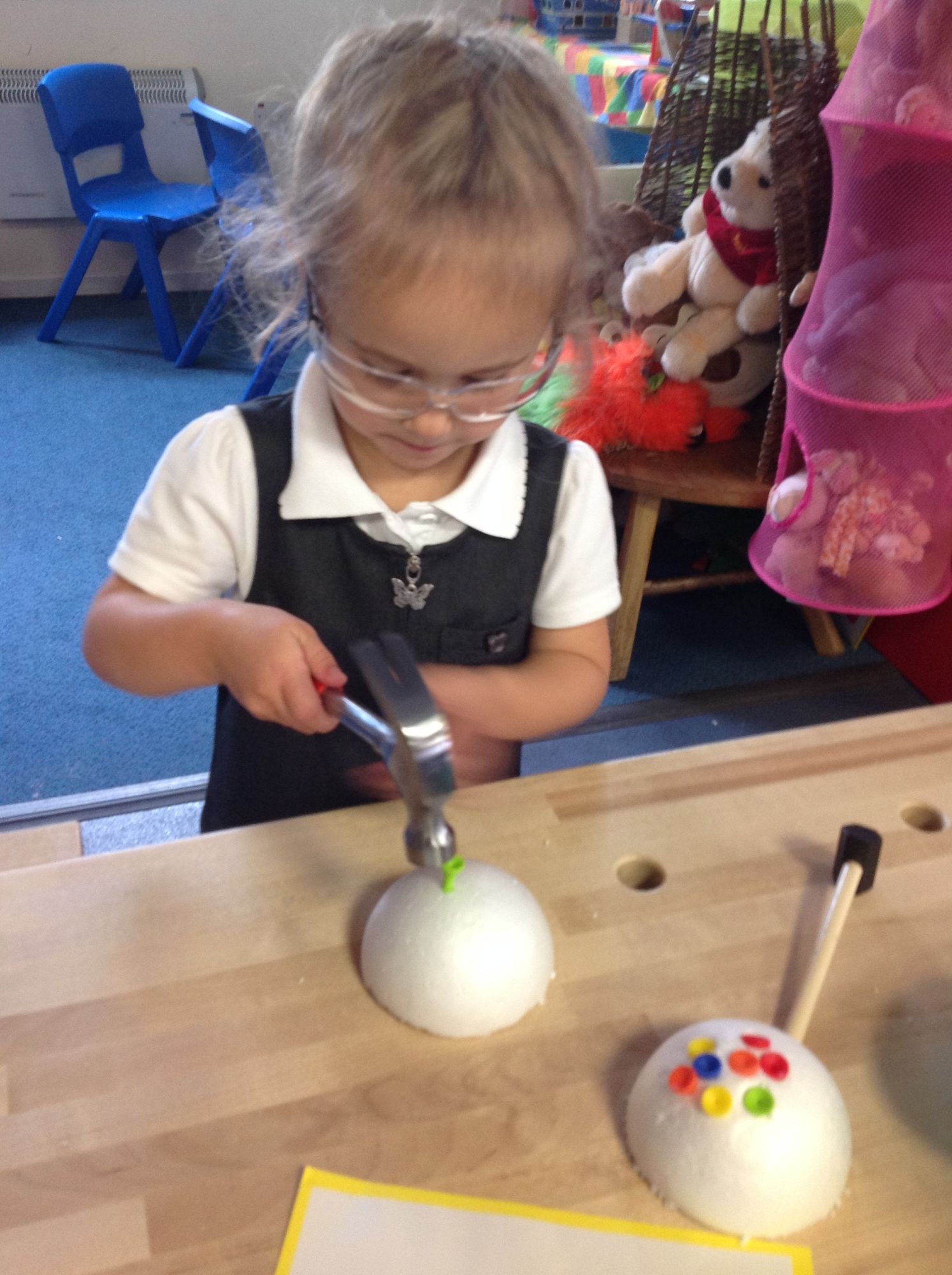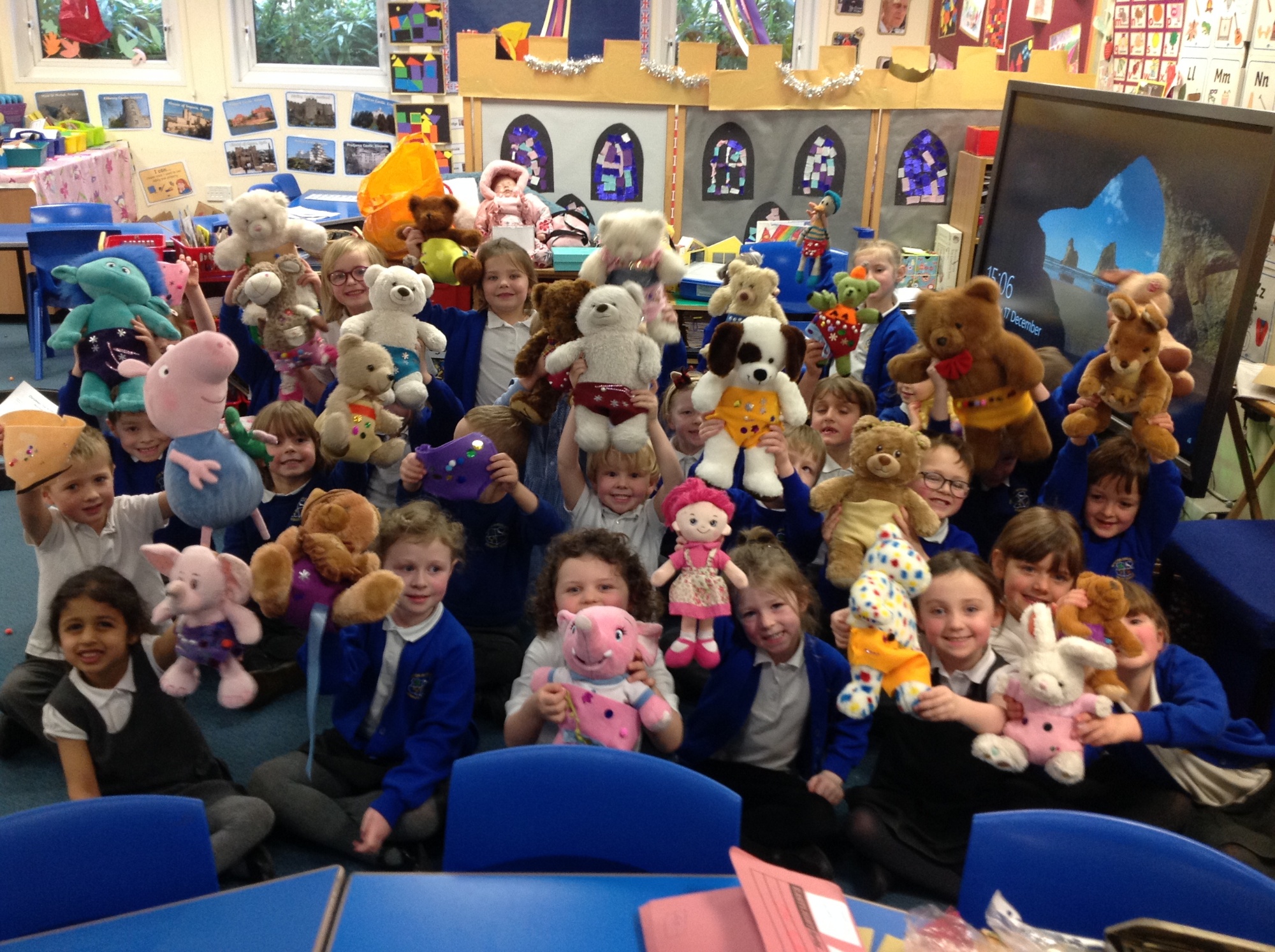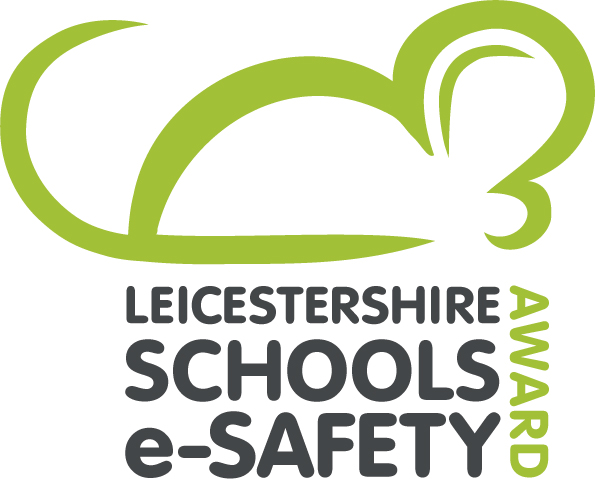Design and Technology
Together We Make Learning A Memorable, Unmissable Adventure
Design and technology is an inspiring, rigorous and practical subject. Using creativity and imagination, pupils design and make products that solve real and relevant problems within a variety of contexts, considering their own and others’ needs, wants and values. They acquire a broad range of subject knowledge and draw on disciplines such as mathematics, science, engineering, computing and art. Pupils learn how to take risks, becoming resourceful, innovative, enterprising and capable citizens. Through the evaluation of past and present design and technology, they develop a critical understanding of its impact on daily life and the wider world. High-quality design and technology education makes an essential contribution to the creativity, culture, wealth and well-being of the nation.
CPD: Primary Art and design 2016/17 All classroom staff
Forest schools: 3 members of teaching staff and 1 member of support staff
Woodwork : 2020/21
Intent
|
We want all learners to reach at least the expected National Curriculum standard by the end of year 6 and to be keen to continue their studies in key stage 3 and beyond. We want learners to be able to see themselves as designers. The design lesson should be one our learners look forward to and greet with enthusiasm. They should leave lessons wanting to find out more. When studying design, learners will draw on their developing learning habits, making progress in their ability to persevere, work effectively as a team, respect and celebrate difference, ask questions and create. We want learners to be interested how things are made and how they work, in both function and form alongside problem solving and enterprise. Our curriculum ensures that pupils can explore 7 key concepts from EYFS to year 6 building knowledge and understanding of: Design, Nutrition, Technology, Data, Functionality, Innovation and Enterprise. |
Approximately, 30 hours are allocated annually to design technology across at least 2 terms
Implementation
|
The majority of work in design technology is inspired by cross-curricular themes or events. We draw on learners’ own experiences and interests. In key stage 2 pupils work together throughout the year to explore: ‘Fridays for the Future’ which includes considering how we can design for sustainability. |
In design work, learners follow the process of research and explore; develop technique; plan and test; create, evaluate and improve. The curriculum is planned and organised so that all learners have the opportunity to revisit and refine knowledge, skills and techniques.
|
When working with materials and textiles learners improve their skills and techniques for cutting and joining. They experiment and explore before making a final artefact, refining, during their primary years, planning, selection, communication and skills. Learners, with increasing sophistication, are able to justify their choices, give and receive feedback and make improvements to their work. In food technology learners are taught basic hygiene and nutrition to complement work done in science. Skills develop progressively from washing, peeling and cutting to experimenting with ingredients and flavours. In forest schools learners gain confidence when working with tools and fire, they work collaboratively and creatively in all weathers developing the ability to risk assess and set personal goals. Assessment, Recording and Reporting In all subjects there are three broad areas for assessment:
Teachers assess learner’s work, their attitudes, increasing skills, knowledge and understanding, by making informal judgements as they observe them during lessons. This assessment enables planning to be tailored to meet learners needs. Assessment encompasses teacher, peer and self-assessment. In all subjects, opportunities for both Assessment for Learning and Assessment of Learning are built into provision. Learners are supported to reflect on their own learning and, age appropriately, to make judgements about their strengths and needs, beginning to plan how to make progress and set personal targets. Baseline assessment, in order to understand pupils’ prior learning, is an essential part of planning to ensure new learning is relevant and progress can be assessed. |
The learners work, in particular baseline assessments and end of unit assessments, which are recorded within learners’ workbooks are used to make decisions at the end of each unit, and at the end of each year, as to next learning steps and whether or not learners are making strong progress and are on track for end of key stage expectation. Progress is recorded and reported to parents as part of the child’s annual school report.
Special Education Needs
Design technology is taught to all children, whatever their ability, in accordance with the school curriculum policy of providing a broad and balanced education to all children. Teachers provide learning opportunities matched to the needs of children with learning difficulties.
our curriculum drivers in design and technology
Reading
In design learners need to be able to read instructions and design briefs then use these to create their own sets of instructions and designs. learners read about important inventors and designers from around the globe to provide both inspiration and aspiration.
Character
In design learners have the opportunity to learn about inspirational inventors and how they have helped to improve the lives of children and others across the world. In design lessons learners collaborate to design, make and evaluate. Learners try out their ideas, test their products and reflect on their successes. This way of working builds resilience and a desire to achieve.
Creativity, reasoning and communication
The Design and Technology curriculum fosters the children’s sense of creativity and allows them to explore a range of their own ideas. Learners can use a range of materials and skills to help meet their design needs. Through cross-curricular links they can incorporate skills learnt in art, science and maths to create detailed, well produced designs.
Impact
|
Prior to the pandemic:
As a result of the pandemic pupils have:
By following the assess, plan, do, review cycle teachers will identify areas which need more or less focus over the next 2 years and support all pupils to make strong progress from starting points. |
Provision for Food technology will be addressed over time including growing for cooking.
the National Curriculum
The national curriculum for design and technology aims to ensure that all pupils:
- develop the creative, technical and practical expertise needed to perform everyday tasks confidently and to participate successfully in an increasingly technological world
- build and apply a repertoire of knowledge, understanding and skills in order to design and make high-quality prototypes and products for a wide range of users
- critique, evaluate and test their ideas and products and the work of others
- understand and apply the principles of nutrition and learn how to cook.
Cooking and nutrition
As part of their work with food, pupils should be taught how to cook and apply the principles of nutrition and healthy eating. Instilling a love of cooking in pupils will also open a door to one of the great expressions of human creativity. Learning how to cook is a crucial life skill that enables pupils to feed themselves and others affordably and well, now and in later life.
Design and technology in early years foundation stage
Expressive arts and design involves enabling children to explore and play with a wide range of media and materials, as well as providing opportunities and encouragement for sharing their thoughts, ideas and feelings through a variety of activities in art, music, movement, dance, role-play, and design and technology
Expressive arts and design has two aspects:
Exploring and using media and materials: children sing songs, make music and dance, and experiment with ways of changing them. They safely use and explore a variety of materials, tools and techniques, experimenting with colour, design, texture, form and function.
Being imaginative: children use what they have learnt about media and materials in original ways, thinking about uses and purposes. They represent their own ideas, thoughts and feelings through design and technology, art, music, dance, role-play and stories.
Learning in design technology will support learning in Maths, Personal, Social and Emotional Development and Communication and Language.
2023
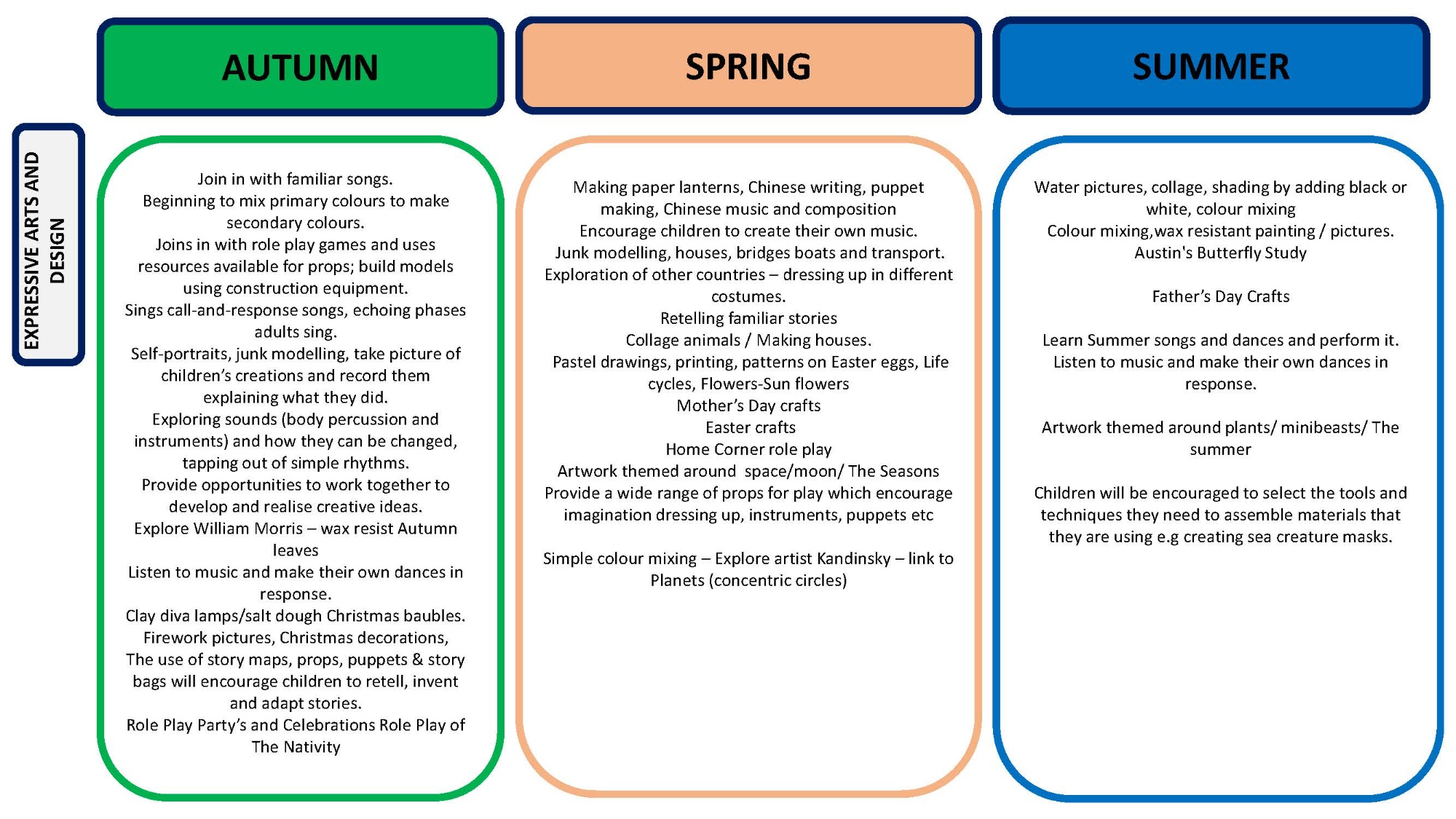
Investigate, design, est, evaluate, make
EYFS :
|
Design: By the end of Foundation the learners will know and be able to: |
|
|
Design
Make
|
Evaluate
Technical knowledge
Cooking
|
|
Design: By the end of foundation learners achieving typically will be able, with some independence, to: |
|
|
|
|
Design: By the end of foundation learners achieving typically know |
|
|
|
Design technology is part of continuous provision in EYFS. Learners have access to wood and tools. They construct with junk and loose parts. A variety of construction kits are available.
KS1 :
|
Design: By the end of KS1 the learners will be able to: |
|
|
Design Design purposeful, functional, appealing products for themselves and other users based on design criteria Generate, develop, model and communicate their ideas through talking, drawing, templates and mock-ups Make Select from and use a range of tools and equipment to perform practical tasks Select from and use a wide range of materials and components, including construction materials, textiles and ingredients, according to their characteristics Evaluate Explore and evaluate a range of existing products Evaluate their ideas and products against simple design criteria |
Technical knowledge Build structures, exploring how they can be made stronger, stiffer and more stable Explore and use mechanisms [for example, levers, sliders, wheels and axles], in their products. Cooking Follow a simple recipe washing, peeling, cutting and weighing ingredients Understand where some foods come from. Knowledge of craft workers and designers Explore the work of others and apply ideas to own work Talk about the work of different craft workers and designers |
|
Design: By the end of KS1 learners achieving typically will be able, with increasing independence, to: |
|
|
|
Class one designed new knickers for the queen! They made prototype knickers using their sewing skills for their teddy bears.
They also made hobbyhorses for the queens stable.
In KS2 :
|
Design: By the end of KS2 the learners will be able to: |
|
|
Design Use research and develop design criteria to inform the design of innovative, functional, appealing products that are fit for purpose, aimed at particular individuals or groups Generate, develop, model and communicate their ideas through discussion, annotated sketches, cross-sectional and exploded diagrams, prototypes, pattern pieces and computer-aided design Make Select from and use a wider range of tools and equipment to perform practical tasks, accurately Select from and use a wider range of materials and components, including construction materials, textiles and ingredients, according to their functional properties and aesthetic qualities Evaluate Investigate and analyse a range of existing products Evaluate their ideas and products against their own design criteria and consider the views of others to improve their work Understand how key events and individuals in design and technology have helped shape the world |
Technical knowledge Apply their understanding of how to strengthen, stiffen and reinforce more complex structures Understand and use mechanical systems in their products [for example, gears, pulleys, cams, levers and linkages] Understand and use electrical systems in their products [for example, series circuits incorporating switches, bulbs, buzzers and motors] Apply their understanding of computing to program, monitor and control their products.
Cooking Understand and apply the principles of a healthy and varied diet Prepare and cook a variety of predominantly savoury dishes using a range of cooking techniques Understand seasonality, and know where and how a variety of ingredients are grown, reared, caught and processed. Knowledge of craft workers and designers Know about great architects and designers in history and apply this knowledge |
|
Design: By the end of KS2 the learners achieving typically will be able, with increasing independence, to: |
|
|
Evaluate products for both their purpose and appearance. Create a design that meets some set criteria. Produce a plan and explain it. Use ideas from other people when designing. Evaluate and suggest improvements for designs. Improve their work when original ideas do not work. Explain how improvements to original designs Present a product in an interesting way. Follow a step-by-step plan, choosing the right equipment and materials. Choose a textile for both its suitability and its appearance. Select the most appropriate tools and techniques for a given task. Make a product which uses both electrical and mechanical components. Work accurately to measure, make cuts and make holes.
|
Describe how food ingredients come together. Know how to be both hygienic and safe when using food. Come up with a range of ideas after collecting information from different sources , including market research Produce and follow a detailed, step-by-step plan. Suggest alternative plans or refine plans; outlining the positive features and draw backs, justifying choices Explain how a product will appeal to a specific audience, considering culture and society Evaluate appearance and function against original criteria. Use a range of tools and equipment competently. Make a prototype before making a final version. Demonstrate both hygiene and safety in the kitchen. Work within a budget. Draw on the work of designers and architects |
This term class 3 are looking at world foods. They made butter in the science unit changing state which they used to create a sandwich (planning, cutting, grating and working to a budget). The next step is to taste a variety of usual ingredients before designing and making a more exotic healthy food choice.
Class 4 are designing and making a buzzer toy to use at a schools council event. This will link work in science to design work.
Woodwork - FOUNDATION AND YEAR 1
The woodwork area is part of continuous provision for year 1, 2 and foundation.
Children are taught to use basic tools safely, so they can construct using wood and variety of lose parts.
By the end of Year 2 learners will be able to:
- Plan their work
- Select the materials and tools they need
- Use the tools safely
- Evaluate their work
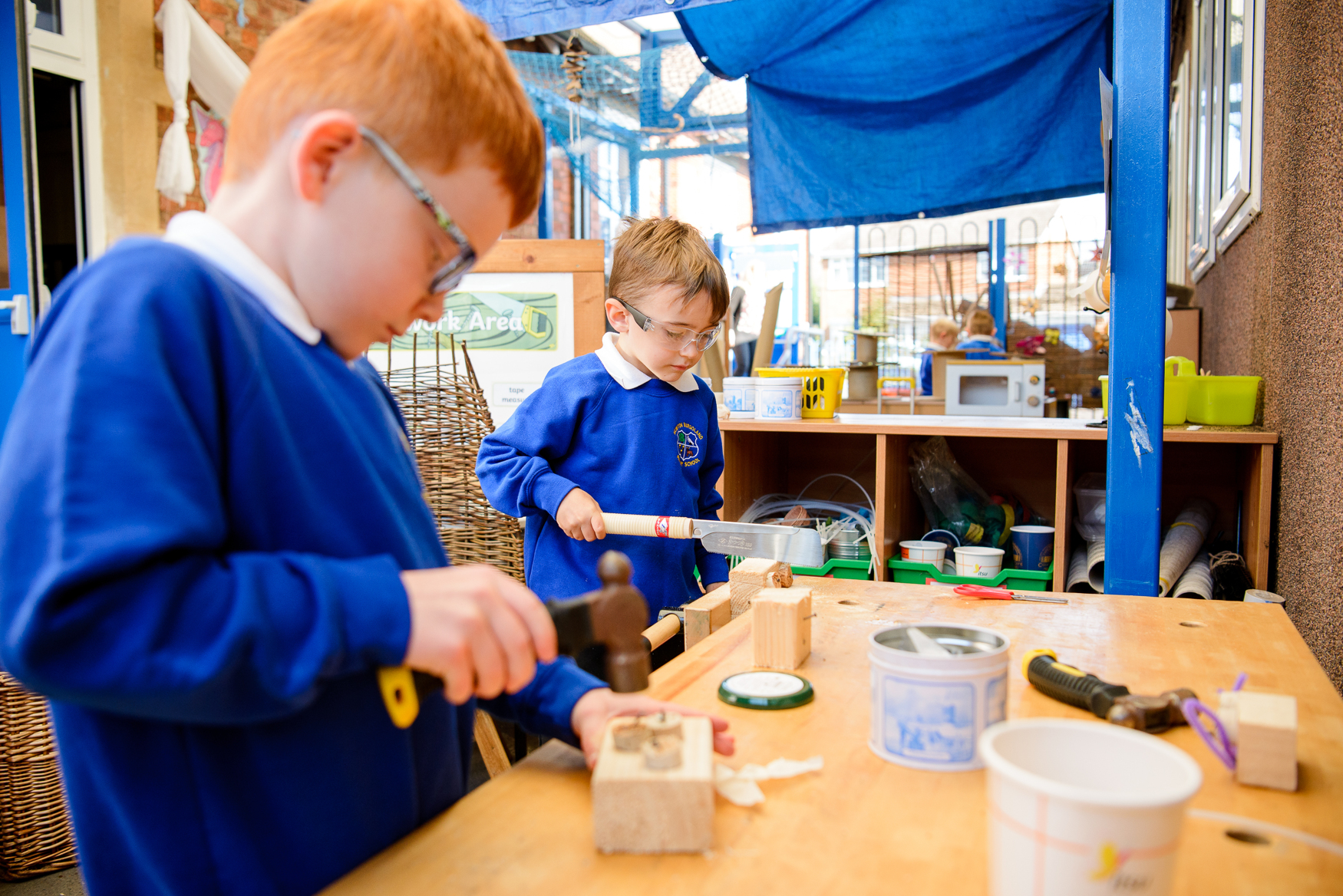
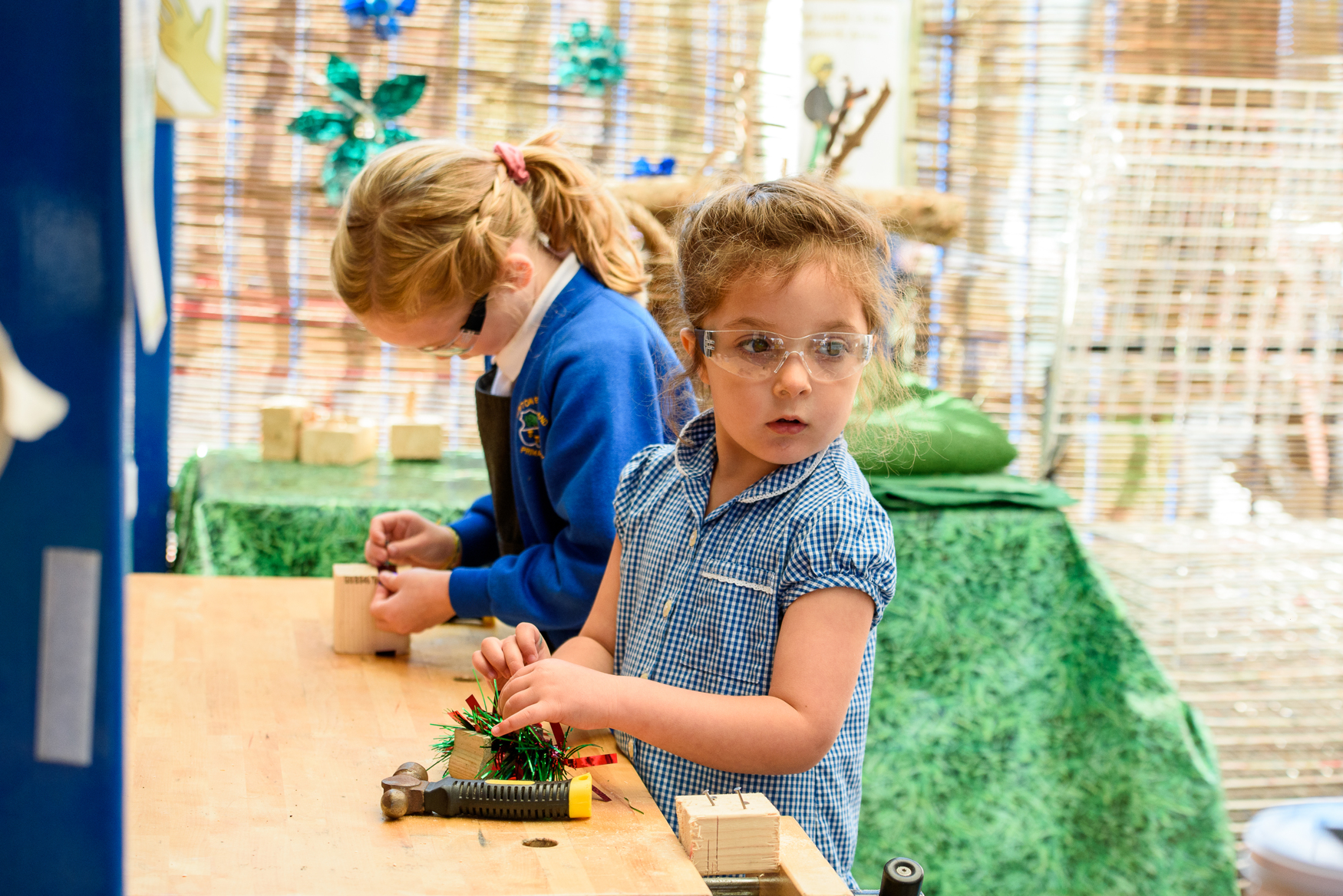
Textiles - FOUNDATION AND Year 1
n this unit of work learners will make mini beast puppets linked to our science topic of growth and life-cycles. Learners will be able to:
- investigate a range of puppets and their features.
- be able to work with fabric to create a finger puppet.
- To develop and practise sewing skills.
- To be able to design a glove puppet.
- To be able to follow a design to make a puppet.
- To be able to evaluate a finished product.
- Children will discuss and explore a range of puppets, their features, what materials are used and what they are used for. They will have the opportunity to choose their favourite puppet, draw and label it. They will to explore and discuss a variety of different finger puppets. Using the template provided, they will work with fabric to create, make and decorate a finger and hand puppet. Children will learn different sewing techniques to use when creating a puppet. They will practise these skills before making their actual puppet. Children will their designs to create their glove puppet. They should think about the appropriate materials to use and to work safely and carefully and finally share and demonstrate their puppets. They will then evaluate their own puppets.
Food - FOUNDATION AND YEAR 1
In this unit of work learners will make a savoury and fruit based dish. They will explore different tastes and textures, find out about where different fruits and vegetables come from and how they grow. Links will be made to learning in science.
By the end of this unit learners will be able to:
- Name different fruits and vegetables.
- Recognise and name at least 5 different fruits and vegetables.
- Say the names of some root vegetables.
- Explain where some food grows.
- Explain that some fruit and vegetables grow above the ground and some grow below the ground.
- Sort the fruits and vegetables into groups that below the ground and groups that grow above the ground.
- Explore and evaluate existing products.
- Taste salads made from root vegetables and explain what I like about them and how they could be improved.
- Say which salad I liked the most and why.
- Explain why I need to eat fruit and vegetables.
- Explain that it is important to eat at least 5 portions of fruit and vegetables a day to help give me energy and keep my body healthy.
- Explain that fruit and vegetables contain lots of vitamins and minerals.
- Prepare and make a healthy salad made from root vegetables.
- Follow the food hygiene rules when preparing food.
- Use kitchen equipment safely when preparing food.
- Assemble and combine ingredients.
- Follow the Food Hygiene Rules.
- Select and safely use a zester and juicer.
- Chop using kitchen scissors and a safe knife.
- Explain where different fruits come from.
- Name some fruits that grow in the UK.
- Explain why some fruits don’t grow in the UK and can say where these fruits grow.
- Prepare a tasty fruit kebab.
- Follow a simple recipe.
- Peel, cut and combine ingredients.
Mechanisms, wheels AND axles -FOUNDATION And Y 1
In this unit of work learners will make a moon buggy. They will explore and evaluate a range of wheeled products such as toys and everyday objects. Through questioning, direct children’s observations e.g. the number, size, position and methods of fixing wheels and axles. How do you think the wheels move? How do you think the wheels are fixed on? Why do you think the product has this number of wheels? Why do you think the wheels are round?
They will draw an example of a wheeled product, stating the user and purpose, and labelling the main parts e.g. body, chassis, wheels, axles and axle holders. • Walk around the school building and grounds, recording how wheels and axles are used in daily life. • Read a story or non-fiction book that includes a wheeled product. Use this to introduce relevant vocabulary and to emphasise user and purpose.
The children will be designing, making and evaluating within an authentic context (moving across the moon surface). The children will evaluate their finished product, communicating how it works and how it matches their design criteria, including any changes they made.
Health and safety Pupils should be taught to work safely, using tools, equipment, materials, components and techniques appropriate to the task. Risk assessments should be carried out prior to undertaking this project.
Textiles- A bag for Life-YEAR 2
In this unit of work learners will evaluate various bags for life and then design and make their own. They will build their knowledge of the design process and further develop skills of self-evaluation. Links are made to climate change and the need to reduce the use of plastic.
By the end of the unit learns will be able to:
- Evaluate a product : bags of life.
- Say what they like and dislike about the design of a product.
- Use existing products to help to start to gather my ideas.
- Design a bag for life and explain ideas
- Create some ideas through drawing sketches.
- Use a paper template to help cut a fabric shape.
- Use chalk to trace around the template
- Cut out the shape for the bag and straps
- Master the skill of using scissors to cut accurately.
- Use a running stitch to join fabric.
- Thread a needle.
- Start off.
- Finish off.
- Select fabrics that are suitable for decorating and decorate
- Describe different types of fabric.
- Select fabrics, join fabrics, describe joining techniques and why they might be selected
- Use design criteria to help evaluate.
- Say two things that went well and one thing that could be improved
models AND MECHANISMS - Easter Cards-YEAR 2
In this unit of work learners will design and make a card for Easter. They will explore existing cards and books with moving parts before designing and making their own card
By the end of this unit of work learners will be able to:
- Explore and evaluate an existing product.
- Look closely at books which have moving parts.
- Say what parts move.
- Explain what the moving part does and how it works.explain what effect it has.
- Evaluate how well it works.
- Use a mechanism in their product.
- Explain what a slider mechanism is.
- Use a slider to make a picture move.
- Measure and cut accurately to make a scene
- Fix a slider to the character that is going to move.
- Assemble the scene and slider.
- Make a lever and for the card deciding how long it needs to be and where to put the pivot
- Make a hole in the picture and lever then use a split pin to assemble it.
- Check that the lever works.
- Move the pivot if the picture doesn’t move how in the planned way
- Make a wheel mechanism and use it in the product.
- Make a wheel mechanism and use it in the product.
- Put a card disc on the background with the edge sticking out.
- Draw a small square on the background and cut it out.
- Use a split pin to fix the disc and paper together.
- Draw four images on the disc.
- Turn the disc to check it moves easily and the pictures look correct.
- Design a working product thinking about who it is for and what it needs.
- Explain why we have design criteria.
- Use design criteria to help create an idea for a moving picture card
- Make decisions about product design and use an annotated sketch to show them.
- Decide which part of the story to make.
- Say which part of the picture will move.
- Sketch the design and label it to show the mechanisms and materials.
- Use mechanisms to make a product.
- Follow the design for a moving picture and use the design criteria
- Make improvements during the making process
- Evaluate the product using the design criteria and identify what went well and where improvements could be made
Food - DIPS AND dippers - yEAR 2
In this unit of work learners taste dips and dippers before creating their own. Links are made to learning in Geography and science preparing pupils for the food and nutrition science unit in lower KS2.
By the end of this unit learners will be able to:
- Evaluate different dips.
- Describe a dip and dipper using sight, smell and taste
- Express like and dislikes about dips and dippers
- Start to think about where different foods come from.
- Name the countries where different dips come from.
- Find the country on a map where a dip comes from.
- Explore different dippers and describe them.
- Explain why humans need to eat a balance and variety of food groups to stay healthy.
- Sort foods in dips and dippers into 5 food groups.
- Explain the Jobs the different food groups do.
- Explain why I should eat more fruit, vegetables and carbohydrates.
- Make dips and dippers.
- Follow the food hygiene rules before and whist making my dip and dippers.
- Safely use a range of kitchen equipment to cut, peel, grate and chop ingredients.
- Name at least three different making words.
- Measure using teaspoons and tablespoons.
- Plan their own appealing dip and dipper and clearly show my ideas.
- Share some ideas about what our product must include be successful.
- Include foods from different groups in my plan.
- Talk through their ideas then use illustrations or notes to plan the making work.
- Follow their plan to make my own dip and dipper.
- Select and use kitchen equipment
- Safely prepare ingredients.
- Evaluate their dip and dipper.
- Say what went well and what could have been improved and how the design criteria has been met
Moving WATER - mechanisms - YEAR 3 AND 4
In this unit of work learners will make a modal of a Shaduf (Ancient Egyptian irrigation system). They will learn about pivots and levers linking learning to work in Science on muscles and bones.
By the end of the unit learners will be able to:
- Investigate mechanical systems.
- Look closely at mechanical systems which use levers and linkages.
- Say what parts move.
- Explain how a system works using the words input and output.
- Make mechanical systems which use levers and linkages.
- Explain the difference between a lever and a linkage.
- Identify levers and linkages.
- Follow instructions to make a lever and linkage mechanism.
- Discuss ideas for design criteria by thinking about who the product is for.
- Develop design criteria to help design an innovative product.
- Adapt existing products to help generate interesting ideas
- Use sketches to develop and communicate ideas.
- Develop ideas using annotated sketches to show the parts which will move.
- Include features of my design criteria when creating sketches.
- Use prototypes to develop ideas.
- Explain what a prototype is.
- Use a prototype to test a product
- Discuss and evaluate a prototype against design criteria.
- Select and use the correct tools and equipment accurately.
- Use the experience of making mechanisms to help select the correct tools and equipment.
- Use tools to accurately cut, shape and join paper and card.
- Carefully select materials and use different techniques.
- Introduce new materials and techniques into a product to create a high-quality finish.
- Look at a range of materials and techniques used by other people and select some to replicate.
- Name the parts and functions of a lever and linkage mechanical system.
- Identify a lever, linkage, loose pivot and fixed pivot.
- Explain the function of the levers, linkage, loose pivot and fixed pivot.
- Evaluate the finished product and identify improvements or changes using the design criteria
Fabric (WEAVING)- YEAR 3 AND 4
In year 2 learners look at different types of fabric when making a bag for life. In this unit learns use magnifying glasses and microscopes to explore how natural material is made. They then design and make a woven product.
In addition, when possible we work with Museum services to explore felt making and with a local crafts person to look at willow weaving.
By the end of this unit of work learners will be able to:
- Find out about important people and events in the past that have shaped the way fabric is made today.
- Make links to local history - the hosiery industry and cotton mills
- Locate the sources of raw materials on a map (cotton, wool, silk)
- Find out about traditional textiles, patterns and manufacturing
- Explain how different textiles are made using weaving techniques
- Explain how to weave and make different patterns with weaving
- Investigate and analyse existing products according to their characteristics.
- Summarise the findings of the market research.
- Develop design criteria.
- Generate ideas for design criteria based on research.
- Develop clear goals that the woven product must achieve in order to be successful, innovative and appealing.
- Use the design criteria to inform the designs.
- Generate a selection of first designs.
- Be inventive with designs whilst still making them appealing to the audience
- Evaluate plans against the set design criteria.
- Develop designs based on design criteria and clearly communicate final designs
- Use initial designs and design criteria to inform the final design.
- Produce annotated sketches to clearly show the final design.
- Verbally explain and communicate the final design.
- Select materials
- Measure accurately
- Evaluate the product against the design criteria.
Edible garden - YEAR 3 AND 4
This unit of work links to work in science on food and nutrition. It contributes to mastery of understanding on how to be healthy - also explored in PSHCE and encourages pupils to try less familiar ingredients. Whenever possible trip to or visit from the local farm shop will take place to support this unit.
This work will feed into our Fridays for the Future Learning when we look at how we can support creating a sustainable planet.
By the end of this unit of work learners will be able to:
- Name some herbs and know how to grow them such as: thyme, mint, parsley, tarragon, rosemary and basil.
- Plant and care for some herbs.
- Explain why herbs need to be in warm places to grow well.
- Explain what makes a diet healthy and varied and cook a healthy balanced meal.
- Explain the eatwell plate and which food should be eaten less
- Explain some of the benefits of eating fruit and vegetables and carbohydrates.
- Follow a recipe to create a balanced meal.
- Explain where, when and how strawberries are grown in the United Kingdom.
- Explain that strawberries are grown outside and in polytunnels and glass
- Explain that strawberry plants produce runners that make new plants.
- Say when the strawberry season is in the United Kingdom.
- Say how to plant and look after a strawberry plant.
- Use kitchen tools correctly to prepare and make a tasty and nutritious drink.
- Safely and correctly use a variety of kitchen tools including a knife, whisk and masher.
- Measure ingredients accurately to the nearest millilitre.
- Carefully follow a recipe, making adjustments when necessary.
- Create a smooth, runny, tasty drink and explain why it is healthy
- Explain when tomatoes are in season in the United Kingdom and can say where and how they are grown.
- Correctly plant a tomato seed.
- Explain that tomato seeds need warmth and water to start to grow and can explain that this is best achieved in warm seasons.
- Explain that tomato plants need air, light, water, nutrients and room to grow.
- Prepare and make a healthy and tasty meal using tomatoes as my main ingredient.
- Prepare ingredients safely and hygienically using appropriate cooking utensils.
- Accurately follow a recipe for tomato bruschetta or tomato sauce.
- Assemble or cook ingredients (controlling the temperature of the hob if cooking).
textiles - Seasonal Stockings- YEAR 3 AND 4
In this unit of work learners will design and make a stocking to hang for Christmas. They will build on previous learning to select materials and tools, making a pattern and using sewing to join materials.
By the end of this unit learners will be able to:
- Discuss and assess the functionality, audience and aesthetics of a variety of Christmas stockings.
- Compare and contrast different Christmas stockings.
- Identify different sewing stitches.
- Thread a needle and secure a knot.
- Join two pieces of fabric together using a sewing stitch.
- Use stitching for decorative purposes.
- Sew a button/bead/sequin/ribbon onto fabric accurately
- See how to combine these skills to create a design for a product.
- Use their knowledge of joining stitches when designing their product.
- Use their knowledge of decorative techniques when designing their product.
- Identify which parts of the making process they may find challenging.
- Follow a design to create a successful product.
- Use appropriate sewing stitches to join and decorate fabric.
- Work safely and sensibly with a range of materials and tools.
- Identify what has been successful with their design.
- Identify any improvements that could be made to the design.
food -Bread- YEAR 3 AND 4
Even the Ancient Greeks ate bread!
However, today there are so many choices!
By the end of this unit of work learners will be able to:
- Find out about important people and events in the past that have shaped the way bread is made and sold today.
- Explain that Warburtons were and still are pioneers of the bread industry.
- Say key events that led to the success of the Warburtons brand.
- Place key events in chronological order.
- Investigate and analyse existing products according to their characteristics.
- Investigate and analyse existing products according to their characteristics.
- Name some of Warburtons existing products.
- Taste different breads and analyse the texture, smell, appearance and flavour.
- Summarise the findings of the market research.
- Develop design criteria.
- Generate ideas for design criteria based on research.
- Develop clear goals that the bread must achieve in order to be successful, innovative and appealing.
- Shape dough.
- Shape dough into rolls and knots.
- Select and create different bread shapes
- Use the design criteria to inform the designs.
- Generate a selection of first designs.
- Be inventive with designs whilst still making them appealing to the audience
- Evaluate plans against the set design criteria.
- Develop designs based on the design criteria and clearly communicate the final design
- Use initial designs and design criteria to inform the final design.
- Produce annotated sketches to clearly show the final design.
- Verbally explain and communicate the final design.
- Select ingredients and kitchen equipment to help follow a bread making recipe.
- Select and prepare ingredients hygienically using appropriate kitchen equipment.
- Knead and bake.
- Measure ingredients accurately to the nearest gram and millilitre.
- Evaluate the product against the design criteria.
- Evaluate the bread against design criteria whilst making it; adjusting and improving when needed.
lighting THE dark - YEAR 3 AND 4
This unit of work enables learners to apply their learning in science to light the dark. It builds on historical learning from year 2 when learners found out about changes within living memory to everyday life. It supports work in computing with 'debugging' a circuit to understand why it is not working.
By the end of this unit learners will be able to:
- Explain how key events and individuals in design and technology have helped shape the world.
- Explain which technological changes have taken place and what enabled those changes to happen.
- Explain what the effects have been and how they have helped shape the world.
- Make and represent different types of circuits.
- Explain that symbols can be used to represent circuit components.
- Create a series and parallel circuit and explain the difference between them.
- Fault find in a circuit.
- Draw circuits using symbols.
- Make and use switches
- Explain that a switch is used to make or break a complete circuit.
- Make different examples of switches and use them in a circuit.
- Identify complete and incomplete circuits.
- Develop design criteria and a design.
- Explain what is meant by design criteria and why they are important.
- Create design criteria for a light, making it fit for purpose and aimed at particular groups.
- Design a product that has a clear purpose and an intended user.
- Develop and communicate an innovative design for a light.
- Communicate ideas about materials, measurements and decoration using an annotated sketch.
- Explain that a cross-sectional diagram is useful to communicate ideas about electrical components.
- Select materials and components to make a light to achieve chosen effect.
- Select appropriate sized batteries and components to hold the battery.
- Select the switch.
- Create a well-finished product.
- Wire up a circuit to the battery and the switch to make the bulb work effectively.
- Add in materials to make the light reflect efficiently so that it works well and looks pleasing.
- Make the lamp look well finished by adding functional and aesthetic decoration.
- Complete a detailed evaluation of the finished product.
- Answer questions aimed at evaluating the light.
- Use the design criteria to inform evaluation.
Global food - YEAR 5 AND 6
This unit of work builds on previous food technology units and links to both geography and Science.
By the end of this unit learners will be able to:
- Say where in the world ingredients come from.
- Name a variety of ingredients from different places.
- Identify on a map places where different ingredients flourish.
- Say how an ingredient might be prepared and used.
- Explain that diets around the world are based on similar food groups.
- Revise the different food groups on the Eatwell plate.
- Explain similarities between different types of food eaten around the world and can say why this is important.
- Place varied foods eaten around the world into the correct food groups.
- Explain why rice is a good staple food.
- Explain the nutritional benefits of rice.
- Explain where rice belongs on the Eatwell plate
- Cook rice.
- Follow a recipe to measure ingredients accurately.
- Use a hob as a heat source to cook rice.
- Explain the importance of correct storage and heating of cooked rice.
- Demonstrate a range of food skills and techniques.
- Grate and dice food.
- Use some more advanced food skills and techniques, such as frying and baking
- Use some basic food skills such as cracking an egg, peeling and shredding.
- Accurately and mainly independently follow a recipe demonstrating a range of cooking techniques.set up a neat and orderly cooking area.
- Accurately follow each step of a recipe.
- Use different cooking techniques.
- Self-evaluate
Marbulous structures- YEAR 5 AND 6
In this unit of work learners create freestanding marble run following design criteria. Learners then have the opportunity to work in teams to participate in the 3M challenge using the knowledge they have gained from this unit of work.
By the end of this unit learners will be able to:
- Investigate freestanding structures.
- Explain the term freestanding structure.explore existing freestanding structures and explain what gives them strength, reinforcement and stability.
- Apply their understanding of structures.
- Use their understanding to build freestanding structures from construction kits.
- Use their understanding to help strengthen, reinforce and stabilise a tall structure.
- Use a wider range of tools and equipment to perform practical tasks accurately.
- Explain different techniques used to join card to other materials.
- Apply these methods when making a marble run bridge.
- Select appropriate tools and equipment to create an accurate and precise finish.
- Evaluate the different joining methods thinking about strength, functionality and aesthetics.
- Develop a range of practical skills to create bends.
- Explore how to create bends.
- Develop practical skills to make bends in a marble run, selecting and using tools and equipment
- Test the bend to make sure a marble runs smoothly through it.
- Investigate existing products.
- Investigate how components fit together to create different marbles runs.
- Focus on components that help to increase the run time of the marble.
- Create a marble run from existing products that takes the longest possible run time for the marble from start to finish.
- Select from and use materials and components to make a marble run.
- Select materials and components that work well functionally to make a marble run.
- Select materials and components according to their aesthetic qualities.
- Aim to be creative and imaginative with my design.
- Evaluate the materials and components used.
- Evaluate and improve design and technology work.
- Use design criteria to evaluate other people’s work.
- Consider the views of others to improve their own work.
- Make improvements to create a high quality finish.
- Use design criteria to create a final evaluation
Textiles (felt phone cases)- YEAR 5 AND 6
In this unit of work learners will design and make phone case. They will need to consider aesthetics, practicalities and audience. Textile skills developed in lower key stage 2 and key stage 1 will be but upon. At this stage they are starting to develop their own design criteria nd investigate the needs of target audience.
By the end of this unit learners will be able to:
- Write a design criteria for a mobile phone case.
- Aim those design criteria at a specific group of people.
- Think about the aesthetics of the phone case.
- Write a design criteria that refers to the functionality of my phone case.
- Generate a range of design ideas and clearly communicate final designs
- Create innovative designs.
- Design with the target market in mind.
- Listen to other people’s ideas.
- Sketch the designs from different angles.
- Add detailed annotations to the design ideas.
- Make a paper template.
- Transfer measurements onto squared paper.
- Accurately cut out templates.
- Explain why templates are necessary.
- Practise using different types of stitches and choose the best one to use on the final felt phone case.
- Explain why the stitch chosen is the most appropriate to use on the final felt phone case.
- Sew a running stitch, backstitch and overcast stitch.
- Create a step by step plan to show the main stages of making
- Explain why it is important to create a step by step plan.
- Use the design criteria to check that each making stage is included on the step by step plan.
- Select decorative techniques and fastenings according to their functional properties and aesthetic qualities.
- Consider functionality when selecting fastenings.
- Select decorations aimed at the target market thinking about colours, patterns and textures.
- Refer to the design criteria to support my choices of fastenings and stitches.
- Evaluate showing how effectively the product meets the design criteria.
- Evaluate any changes that have been made to the final product.
Automata animals
As learners move through KS2 they will become more adept at developing design criteria and self-evaluation. This unit supports previous learning in geography and the importance of using the Internet safely when searching.
By the end of this unit learns will be able to:
- Research ideas about different animals to inform design.
- Use the Internet and information books to research endangered and vulnerable animals.
- Gather ideas and explain how they move that will inform my design.
- Gather ideas and explain their appearance and habitat to inform my design.
- Explain how simple cam mechanisms work.
- Explain what a cam and follower are.
- Identify cams and followers on mechanisms.
- Explain how rotary motion is converted into linear motion in a mechanical system.
- Make a simple mechanism to show understanding of cams.
- Explain how using a snail and egg shaped cam changes the movement of the mechanism.
- Make a mechanism and change the shape of the cam to see how this changes the movement of the follower.
- Select materials according to their functional properties.
- Choose appropriate sheet materials to make a simple cam mechanism.
- Explain why the material is fit for the purpose.
- Use research and develop design criteria to inform the design.
- Explain what design criteria are and why they play an important role in product development.
- Use the acronym CAFEQUES to help develop design criteria.
- Use the design criteria to develop an innovative design.
- Use the research about animals from lesson 1 to inform the design.
- Build a framework accurately using a wider range of tools and equipment.
- Use a hacksaw and bench hook to cut wood accurately to 1mm.
- Join materials using card triangles or pin nails.
- Use sandpaper to ensure a smooth finish.
- Evaluate and improve by listening to others and using design criteria
- Understand and use a mechanical system.
- Select materials to make the cams from.
- Accurately measure and cut the dowel wood for use as the axle/shaft.
- Make a handle to work the mechanical system for my automata.
- Make adjustments to the mechanical system to make it function well.
Super seasonal cooking - YEAR 5 AND 6
This unit of work will build on learners understanding of seasonality form year 3 and 4 when they looked at tomatoes and strawberries. Learners will again visit the concept of an eatwell plate to guide our food choices ensuring that over time, this learning is secure.
By the end of this unit of work learners will be able to:
- Explain what seasonality means and know when different fruit and vegetables are in season in the United Kingdom.
- Explain that fruit and vegetables are in season when they are naturally ripe.
- Name the seasons when cherries, Brussels sprouts, pumpkins, blackberries, peas and parsnips are in season.
- Use the seasonal fruit and vegetable chart.
- Explain where, when and how a variety of ingredients are reared, caught and processed.
- Say what the words reared, caught and processed mean.
- Name some foods that are reared, caught and processed and can say where some of these foods come from.
- Explain that reared and caught foods are also seasonal.
- Taste and evaluate seasonal foods and recognise that sometimes we need to try a new food a few times to find out if we like it.
- Enjoy tasting new seasonal foods describing the taste, texture and smell.
- Say which ingredients I preferred and explain why.
- Explain the importance of protein as a proportion of a healthy varied diet.
- Explain the eatwell plate and know the proportions of a balanced meal.
- Explain some of the benefits of eating protein.
- Say which foods are good sources of protein.
- Work as a group to generate, evaluate and refine recipe ideas.
- Generate creative ideas about food.
- Work well as a group, sharing my ideas and listening to the views of others.
- Take feedback and improve designs.
- Clearly communicate final designs.
- Include an annotated diagram final designs.
- Communicate my choice of ingredients, methods, cooking times and temperatures.
- Explain how to correctly store and handle meat and fish.
- Give at least 4 key rules for storing and handling raw and cooked fish and meat.
- Explain the system of using different chopping boards.
- Prepare, cook and evaluate a healthy seasonal meal.
- Demonstrate a range of preparation techniques.
- Use different cooking techniques such as grilling, griddling, frying and boiling.
- Refine recipes including ingredients, methods and cooking times.
- Evaluate the final product against the design criteria.

